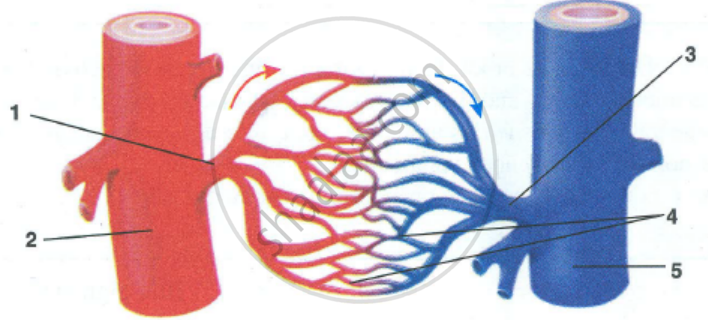Advertisements
Advertisements
प्रश्न
Given below is a simple diagram of the circulation of blood in a mammal showing the main blood vessels, the heart, lungs, and body tissues. The blood vessel labeled 6 contains deoxygenated blood and 2 the valve leading to it has three semi-lunar pockets.
(i) Name the blood vessels of organs marked by numbers 1 to 8.
(ii) What do you mean by the term ‘double circulation’ of blood in mammals?
(iii) What is diastole?
उत्तर
(i)
1. Veins from tissues.
2. Superior vena cava
3. Aorta
4. Right ventricle
5. Left ventricle
6. Pulmonary Artery
7. Pulmonary vein
8. Lungs.
(ii) The heart is said to have double circulation because the blood passes through the heart twice.
(a) It first leaves t.rough the right ventricle, goes to the lungs and then returns to the left auricle of the heart (pulmonary circulation).
(b) It leaves through the left ventricle, circulates through the body, and again returns to the right auricle of heart (systemic circulation).
(iii) Diastole is the phase of relaxation of the heart muscles during which the heart chambers fill with blood and the supply of blood to the cardiac muscle is improved.
APPEARS IN
संबंधित प्रश्न
Name the largest artery
Fill in the blank with suitable word given below:
The liquid part of coagulated blood is known as____________.
Given below is a diagrammatic representation of certain types of blood vessels in human body.

Where can such an arrangement be found as an example - in lungs or in heart walls?
Name the blood vessels entering the heart and leaving the heart.
Name the Following
The blood vessel leaving the left ventricle of the mammalian heart
Assertion: Veins have thin walls to collect blood from different organs.
Reason: Blood in veins are not under pressure.
Differentiate between an artery and a vein.
The substances to and from the tissues diffuse through the walls of ______.
Name these:
Three kinds of blood vessels.
